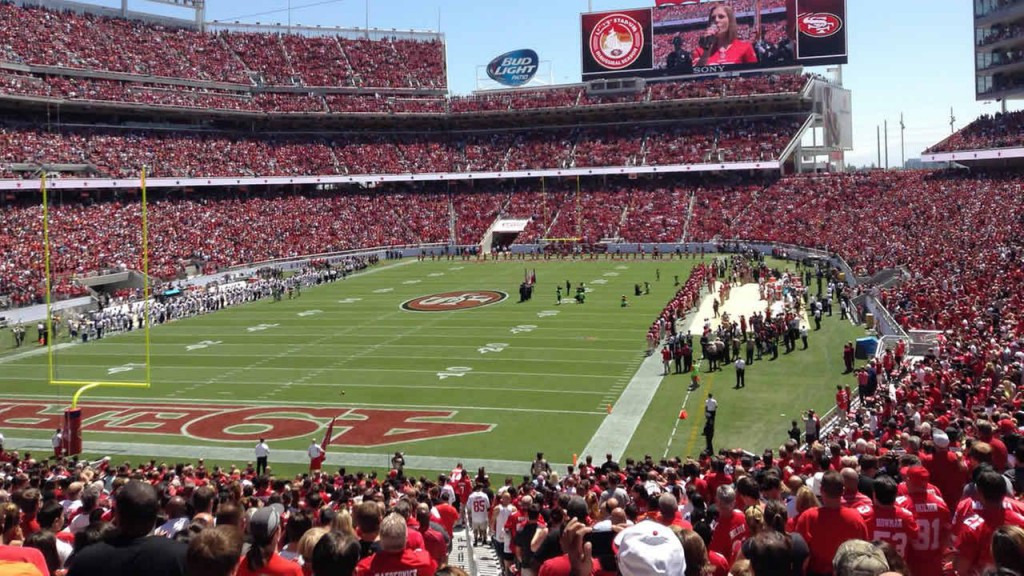By Cutright Elizabeth on January 27, 2016 in News
On February 7, 2016, the Carolina Panthers and the Denver Broncos will battle it out at Super Bowl 50 in the LEED Gold Certified Levi’s Stadium; one of the nation’s most technologically advanced sporting venues.
Three years ago, a thrilling super bowl featuring a rally by the San Francisco 49ers during the second half turned a would-be shutout into a hard-fought, 34-31 win for the Baltimore Ravens. Though t he game was action packed, one of the most startling moments happened right after halftime when the entire 73,000-seat arena went dark for 34 minutes. When the lights returned, the 49ers rallied, closing a 28-6 halftime score and almost sparking what might have been “the greatest comeback in Super Bowl history.”
he game was action packed, one of the most startling moments happened right after halftime when the entire 73,000-seat arena went dark for 34 minutes. When the lights returned, the 49ers rallied, closing a 28-6 halftime score and almost sparking what might have been “the greatest comeback in Super Bowl history.”
Clearly the 49ers took that blackout to heart, as evidenced by the team’s own Levi’s® Stadium, a state-of-the-art sporting facility touted as “the most high-tech stadium in the world.”
An Homage to the Future
“The stadium is built in the middle of the heart of technology,” declares Senior VP of NRG Business Solutions Robert Gaudette in an NRG video of the building’s construction. “It’s also at the center aisle of the newest thinking around what energy is.”
Dan Williams, former VP of Technology for the 49ers expands on how technology was paramount as plans for the building evolved, saying “One of the focuses was ‘let’s ensure that it’s truly a technology driven stadium, and let’s try to adopt what makes Silicon Valley Great.’”
Recognized as “2015 Sports Facility of the Year” by Sports Business Journal and “Venue of the Year” by The Stadium Business Awards (Barcelona, Spain), Levi’s® Stadium was also awarded LEED Gold certification by the U.S. Green Building Council (USGBC), the first NFL stadium to earn that designation.
“When we looked at building this stadium, we really built it on three pillars,” explains Al Guido (COO, San Francisco 49ers). “We built it on sustainability, technology, and fan experience.”
Sustainable by Design
While the Super Bowl will certainly shine a spotlight on Levi’s® Stadium, the facility – which opened on July 17, 2014 – has already experienced its fair share of historical moments, including a history-making Grateful Dead tribute concert boasting 83,000 in attendance. In fact, its initial design emphasized adaptability and the need for the field to accommodate everything from motocross races to FIFA soccer matches to innumerable indoor/outdoor community events and conferences.
From its inception, the coliseum’s environmental pedigree was readily apparent. During the project’s assembly, 75% of non-hazardous construction waste was diverted, recycled or salvaged and the Citrix Owners Suites are embellished with 100% reclaimed wood. NonCFC-based refrigerants were used, and composting and recycling are utilized and encouraged throughout the property.
The list of environmental features included in the project’s construction covers a whole host of sustainability technologies and attributes. Paving and roofing materials with high solar reflectance indexes encompass the building’s exterior, while a 27,000 square foot green roof and photovoltaic panels top the structure. More panels adorn a pedestrian bridge and solar terrace, bringing the total number to 1200, enough to ensure game days are net-neutral to the grid.
“Our NFL game days are powered by the sun,” brags Williams.
Inside, advanced lighting panels and programmable thermal comfort systems manage climate control efficiently and effectively. Low-flow plumbing fixtures work in concert with recycled water to reduce water use and support landscape irrigation, including a pitch that uses 50% less water than traditional turf.
Visitors curious about energy usage can view a dashboard displaying real-time measurements of energy demand, water use, and other “dynamic green features as the building operates.” Patrons will also be able to avail themselves of concession fare supplied by local businesses and featured on “farm-to-table” menus.
Focus on Community and Accessibility
Locale is another key a sustainability feature. Situated near trails and rail lines, alternative transportation to the venue is easy and attractive. Ticket holders can arrive via public transit using the VTA Light Rail system, which delivers passengers to three stations within walking distance. Additionally, the arena sits just east of Santa Clara’s San Tomas Aquino Trail, a 100-mile network of footpaths open to pedestrians and cyclists.
When the seats fill up, and the viewers tune in, Super Bowl 50 will most likely be remembered for the gameplay and the final score. Few spectators will be aware they are witnessing history as the tackles and the touchdowns play out in Santa Clara’s sleek, groundbreaking “golden bowl.”
“I think it was a mandate that we were responsible to the community, and we were responsible to the environment,” concludes Guido. “I think all those [sustainability attributes] go into the sustainable story, and I think our fans really enjoy those components.”
“It’s a movement across the country to become more sustainable, to be more friendly to the environment, and stadiums have to do their part.”


